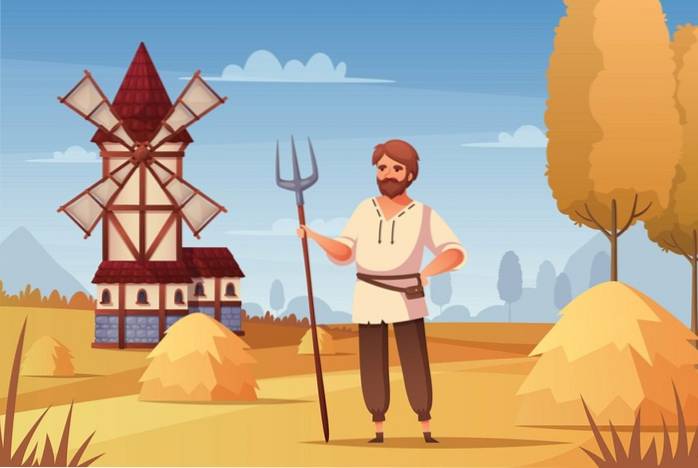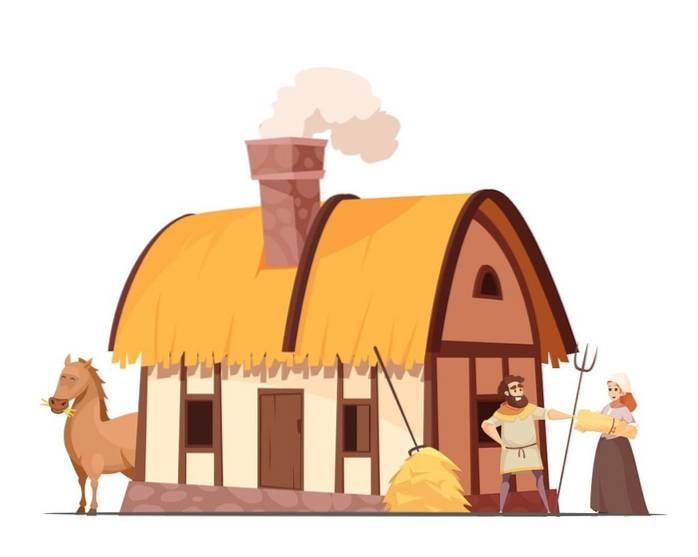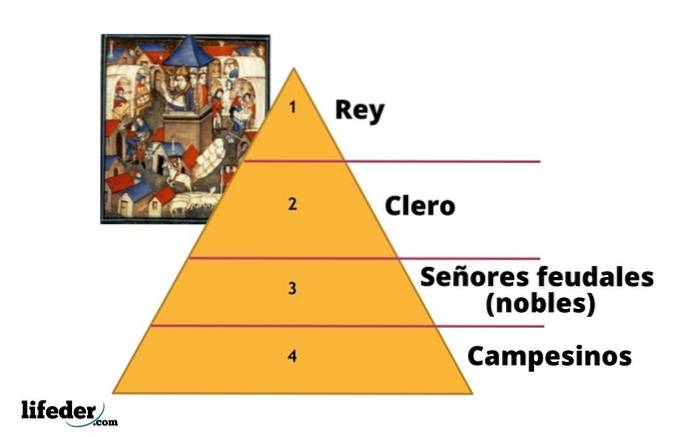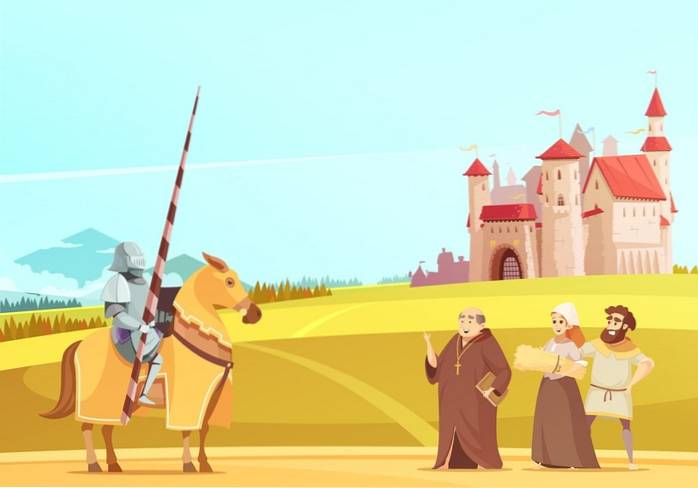
Feudal mode of production

What is the feudal mode of production?
The feudal mode of production refers to the dominant economic and social system in medieval Europe, where the feudal lords belonging to the nobility owned the lands, while the peasants or serfs were obliged to live on the land of their lord, this determining the existing production relationship.
These lands formed large productive agricultural units, owned by these noble lords, who could demand that the peasants pay a rent, either with their work, products or monetary tributes..

In exchange, peasants could own small properties and also have access to pastures and forests, which were common lands..
This reflected a subordinate relationship of the servant with respect to the feudal lord, as this was the supreme authority over the land or fiefdom, which included his property, peasant lands and common land..
Feudalism was a fundamental stage in the historical development of society, spanning a long period. In Europe it ranged from the fall of the Roman Empire (5th century) to the bourgeois revolutions in England (17th century) and France (18th century). It was defined as a mode of production by Karl Marx and Friedrich Engels.
Origin of the feudal mode of production
End of the Roman Empire
Tribes from different parts of Europe destroyed the Roman Empire. The power of the slaveholders was overthrown and slavery fell. Large estates and slavery-based craft workshops collapsed.
The elements of the feudal mode of production would have originated within the slave society, in the form of the tribal system.
Slavery had ceased to exist. Thus, the development of the productive forces was only possible based on the work of a mass of dependent peasants, who owned their own properties and their own instruments of production..
Decline of the tribal system
The conquering tribes acquired much of the state lands and large landowners. The forests and pastures were still in common use, but the farmland was divided into several properties.
Later, these lands became the private property of the peasants, thus forming a broad stratum of small independent peasants. However, the peasants could not retain their independence for long. Among the peasants there were wealthy and poor families.
As property inequality increased, those who had become rich began to gain power over the community. The poor came to depend on these great feudal lords.
Features of the feudal mode of production

The feudal mode of production has several characteristics that differentiate it from other modes of production described by Marx:
- The feudal lord was the owner of the land and the means of production.
- The workers had a partial slavery relationship. They were partially owners of their farms and some work tools.
- The feudal property encompassed several villages, from which they obtained their profits.
- Production was for subsistence. Serfs produced for their own food and less for commercial exchange.
- The feudal activities were basically agrarian, to produce food. Although some industries existed, most people farmed the land for a living.
- The feudal mode of production in Europe led to the building of armies. Armies and other classes, such as kings and nobles, were supported by what was produced on their properties. The serfs were the producers of the lords.
- The feudal lands had two functions. First, to generate profits for the feudal lord through agriculture produced by the peasants. And second, to generate profits for the peasant's farm, where he will produce his own food..
Production ratio
The feudal mode of production was based on the ownership of the land by a feudal lord, as well as the partial ownership of peasants and serfs who lived on their land. Dependent serfs farmed and ran small economies on that land.
The peasant serf was not a slave, because he could have his own possessions. There was the possession of the peasants of their production implements and of their own properties, based on their personal work. Although the feudal lord could sell him, he couldn't kill him.
The relationship between the feudal lord and his servants was not only economic, but also social. The tenant was a vassal of the lord, that is, he was bound to him by an oath of allegiance. On the other hand, the owner was obliged to protect and respect his vassals.
The economy was basically based on generating profits in order to comply with the requests of the feudal lords, by taking advantage of the peasants who depended on them..
Social classes of the feudal mode of production

The king
In the Middle Ages the highest authority was the king, although he was very close to the power of the church. Kings were thought to have a divine right to reign and came to the throne through conquests, popular clamor, elections, or by inheritance..
Clergy
The Church became the largest feudal landlord. The donations of the princes and the endowments made her the possessor of extensive lands and the richest properties of those times, with a numerous dependent and servile population. It was the ruling domain along with the kings and feudal lords (nobles).
Feudal Lords (Nobles)
This class was not entirely uniform. The small feudal lords paid tribute to the most powerful, but on the other hand they took advantage of their patronage. The patrons were called baron or lord. In turn, these were vassals of even greater barons or lords. Likewise, the highest authority to which everyone owed respect and obedience was the king. This is how the feudal hierarchy was formed.
As the ruling class that made up the nobility, the feudal lords were at the head of the state. They occupied the distinguished position of first state and had broad political and economic privileges..
Peasants or serfs
The broad base of the feudal scale was the peasantry. The peasants were subordinate to the feudal lord and under the supreme power of the king. It was a class without political rights.
Serf owners subjected them to physical punishment. The use of peasants could be almost as cruel as the exploitation of slaves in the ancient world. However, the servant could work part of the time on his own property and, to some extent, could be independent.
The bourgeoisie
In the transition from the feudal mode of production to capitalism, a new social class emerged that corresponded neither to the nobility nor to the peasantry. It is about the bourgeoisie, that is, merchants, artisans or new professionals who emerged mainly from the cities.
The bourgeoisie transformed the feudal mode of production. Through the bourgeois revolutions produced between the Middle Ages and the Modern Age, they managed to position themselves as one of the ruling classes.
Advantages and disadvantages

Advantage
The servant is not a slave
Work was no longer unworthy of the free man, but physical work was regarded as basic and mental as noble. This justified the division of the company into properties. The feudal lords no longer had the right to kill a serf.
Wealth according to social position
Each person possessed wealth according to their position in the hierarchical ladder. Thus, a “fair” price was sponsored, which should reflect the amount of labor used to produce a commodity and the producer's assets..
It was sought to limit the commercial profit within certain limits, so as not to threaten the economic existence of the other properties.
Rise of capitalism
The great monetary wealth concentrated in the hands of great feudal lords prepared the conditions for capitalism to emerge. The bourgeoisie used the struggle of the peasants against the feudal lords to seize power.
With capitalism, the development of the productive forces was generated, forming the classes of a new society, wage earners and capitalists..
Disadvantages
The production relations of feudalism, the low productivity of the unfree labor of the serfs, and the union restrictions hampered the further development of the productive forces..
The free peasantry was ruined by incessant military service, looting, and taxation. The peasants demanded the abolition of feudal privileges, to establish equal rights, in addition to abolishing wealth.
Themes of interest
High Middle Ages.
Middle Ages.
Asian production mode.
Slave production mode.
Capitalist mode of production.
Socialist mode of production.
Primitive communism.
References
- Economics Institute of the Academy of Sciences of the U.S.S.R. (2020). The Feudal Mode of Production. Taken from: marxists.org.
- Encyclopedia (2020). Feudal Mode of Production. Taken from: encyclopedia.com.
- Elizabeth Brown (2020). Feudalism. Britannica. Taken from: britannica.com.
- Wikipedia, the free encyclopedia (2020). Mode of production. Taken from: en.wikipedia.org.
- California Digital Library (2020). Feudalism and the Transition to Capitalism. Taken from: publishing.cdlib.org.



Yet No Comments